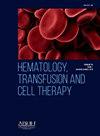PRELIMINARY RESULTS FROM A MULTICENTER PHASE 2/3 STUDY OF NEXT-GENERATION SICKLE HEMOGLOBIN POLYMERIZATION INHIBITOR OSIVELOTOR (GBT021601) FOR THE TREATMENT OF PATIENTS WITH SICKLE CELL DISEASE
IF 1.8
Q3 HEMATOLOGY
引用次数: 0
Abstract
Objectives
Osivelotor (previously GBT021601) is a next-generation sickle hemoglobin (HbS) polymerization inhibitor in development for sickle cell disease (SCD). Compared with the first-in-class HbS polymerization inhibitor voxelotor, osivelotor has improved pharmacokinetic properties, which may enable higher Hb occupancy at lower doses to potentially reduce treatment burden and improve clinical outcomes. We report preliminary phase 2 data from an ongoing phase 2/3 study of osivelotor in SCD.
Methods
Preliminary data are reported from Part A of a 3-part, multicenter phase 2/3 study (NCT05431088). Part A is a randomized (1:1), open-label, 12-week, dose-finding study of oral osivelotor in patients with SCD (HbSS/HbSβ0 genotype) aged 18–65 y and Hb 5.5–10.5 g/dL. Patients received a loading dose twice-daily for 4 days then once-daily maintenance doses (100 or 150 mg) through Week 12. The primary endpoint was change from baseline in Hb at Week 12. Secondary endpoints included ektacytometry (Oxygenscan) to assess red blood cell (RBC) deformability as a function of the partial pressure of oxygen, expressed as elongation index (EI).
Results
At cutoff date (June 20, 2023), 35 patients had been treated (osivelotor 100 mg, n = 17; 150 mg, n = 18); 28 had completed 12 weeks’ treatment. Mean (range) age was 29.7 (18–59) y, 32/35 patients were HbSS, and 16/35 were on stable hydroxyurea at baseline. Increases in Hb from baseline were seen from Week 1 and sustained to Week 12. At Week 12, for the 100-mg (n = 13) and 150-mg (n = 12) groups, respectively, mean (SD) increases from baseline in Hb (g/dL) were 2.63 (1.42) and 3.27 (1.70) and in hematocrit (%) were 7.83 (4.06) and 9.73 (4.26); mean (SD) changes in erythropoietin (IU/L) were –121.7 (346.3) (n = 13) and –89.9 (243.4) (n = 11). Indirect bilirubin and reticulocytes also showed reductions from baseline. Ektacytometry showed EI increased and point of sickling (PoS) during deoxygenation decreased from baseline to Week 12. For 27 patients with ≥1 vaso-occlusive crisis (VOC) at baseline, the annualized VOC rate (95% CI) was 2.30 (1.85–2.86) at baseline and 1.20 (0.58–2.48) on-study, with median (range) on-study duration 0.4 (0.03–0.41) y. Treatment-emergent adverse events (TEAEs) were reported for 20 patients (57.1%). Treatment-related TEAEs, reported for 6/35 patients (17.1%), were headache (n = 4), diarrhea (n = 2), and abdominal discomfort, nausea, upper abdominal pain, and urticaria (n = 1 each). One death, deemed unrelated to osivelotor, was due to a cerebrovascular accident (CVA) in a patient with a history of CVA and seizures, after new-onset high fever and no change from baseline in Hb (8.0 g/dL).
Discussion
In preliminary results from Part A of this phase 2/3 study, loading and daily doses of osivelotor for 12 weeks were well tolerated in adults with SCD. Results to date show large increases in mean Hb accompanied by improvements in markers of hemolysis. Although oxygen delivery was not directly measured, no impairment was suggested by indicators of oxygen delivery (ie no increases in erythropoietin levels or VOCs). Ektacytometry results suggested improvement in RBC deformability and delayed HbS polymerization.
Conclusions
These results support ongoing clinical development of osivelotor as a potential SCD therapy.
Funding
This study was sponsored by Pfizer.
治疗镰状细胞病患者的新一代镰状血红蛋白聚合抑制剂 osivelotor (gbt021601) 2/3 期多中心研究的初步结果
目的osivelotor(原名 GBT021601)是一种正在开发的下一代镰状血红蛋白(HbS)聚合抑制剂,用于治疗镰状细胞病(SCD)。与第一类HbS聚合抑制剂voxelotor相比,osivelotor的药代动力学特性有所改善,可以在较低剂量下获得更高的Hb占有率,从而有可能减轻治疗负担并改善临床疗效。我们报告了正在进行的osivelotor治疗SCD的2/3期研究的2期初步数据。方法报告的初步数据来自3部分多中心2/3期研究(NCT05431088)的A部分。A 部分是一项为期 12 周的随机(1:1)、开放标签、剂量摸底研究,研究对象为 18-65 岁、血红蛋白 5.5-10.5 g/dL 的 SCD(HbSS/HbSβ0 基因型)患者。患者接受为期 4 天、每天两次的负荷剂量治疗,然后接受每天一次的维持剂量(100 或 150 毫克)治疗至第 12 周。主要终点是第 12 周时 Hb 与基线相比的变化。次要终点包括电子血细胞计数法(Oxygenscan),用于评估红细胞(RBC)作为氧分压函数的变形性,以伸长指数(EI)表示。结果截止日期(2023年6月20日),35名患者接受了治疗(奥司洛特100毫克,n = 17;150毫克,n = 18);28名患者完成了12周的治疗。平均(范围)年龄为 29.7(18-59)岁,32/35 名患者为 HbSS,16/35 名患者在基线时服用稳定的羟基脲。从第 1 周开始,Hb 从基线开始上升,并持续到第 12 周。第 12 周时,100 毫克组(n = 13)和 150 毫克组(n = 12)的 Hb(g/dL)与基线相比的平均(标度)增幅分别为 2.63(1.42)和 3.27(1.70)和血细胞比容(%)分别为 7.83(4.06)和 9.73(4.26);促红细胞生成素(IU/L)的平均(标度)变化分别为-121.7(346.3)(n = 13)和-89.9(243.4)(n = 11)。间接胆红素和网织红细胞与基线相比也有所下降。细胞计数显示,从基线到第 12 周,脱氧过程中 EI 增加,镰状细胞点 (PoS) 减少。基线时血管闭塞性危象(VOC)≥1 例的 27 名患者中,基线时年化 VOC 率(95% CI)为 2.30(1.85-2.86),研究期间为 1.20(0.58-2.48),研究期间中位数(范围)为 0.4(0.03-0.41)年。35例患者中有6例(17.1%)报告了与治疗相关的TEAE,包括头痛(4例)、腹泻(2例)、腹部不适、恶心、上腹痛和荨麻疹(各1例)。讨论在这项2/3期研究A部分的初步结果中,SCD成人患者对持续12周的负荷剂量和每日剂量奥希洛洛耐受性良好。目前的结果显示,平均血红蛋白大幅增加,同时溶血指标也有所改善。虽然没有直接测量氧输送,但氧输送指标(即促红细胞生成素水平或挥发性有机化合物没有增加)表明氧输送没有受损。Ektacytometry结果表明,红细胞变形性和延迟HbS聚合均有所改善。结论这些结果支持将osivelotor作为一种潜在的SCD疗法进行临床开发。
本文章由计算机程序翻译,如有差异,请以英文原文为准。
求助全文
约1分钟内获得全文
求助全文
来源期刊

Hematology, Transfusion and Cell Therapy
Multiple-
CiteScore
2.40
自引率
4.80%
发文量
1419
审稿时长
30 weeks
 求助内容:
求助内容: 应助结果提醒方式:
应助结果提醒方式:


